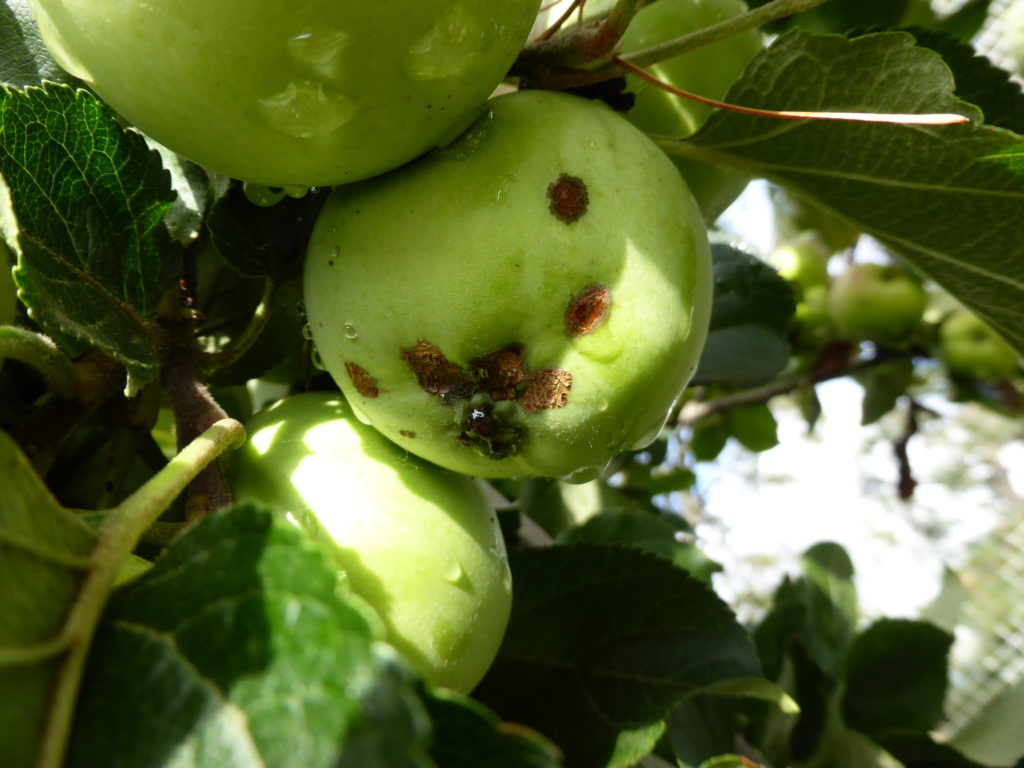Just like dessert apples, cider apples can get black spot (Venturia inaequalis) also know as apple scab.

Black spot infection occurs when there is a combination of spores in the orchard environment and the plants are subject to periods of wetness in conjunction with temperatures favourable to development. Tables for this are available on the internet eg:
https://www.dpi.nsw.gov.au/agriculture/horticulture/pomes/pests-etc/apple-and-pear-scab
Protective fungicides and fungicides with a degree of curative action are available. The infection occurs on leaves and fruit and the extent to which they are affected varies between cultivars. My cider apple orchard is operated as an experimental block rather than a commercial operation. For this reason I often undertake management practices which are outside guidelines in order to gather more understanding of the cider cultivars.
This season I chose not to undertake a spray program for black spot and with the weather that was experienced not surprisingly there has been disease development. Assessment of the black spot has been via a subjective ranking of the degree of infection of the fruit, utilising a 0-10 scale where 0 is no fruit infected and 10 is virtually all fruit infected. Ranking was in whole numbers but averaging across multiple trees of the same cultivar has resulted in some ‘decimal’ ranks.
In considering these data be aware that it is for one season only. Therefore treat it as a guide to the behaviour of the cultivar, remembering that an appropriate spray program would probably see all cultivars ranked at 0. Similarly in a season less conducive to black spot development overall rankings would probably be lower.
From another perspective, the data could well be useful for someone considering a minimal spray orchard – or an organic operation – as it highlights those cultivars with inherent disease resistance.
For comparative purposes the table starts with dessert cultivars followed by the cider cultivars.
| Average rank | |
| Granny Smith | 10 |
| Hi Early (Red Delicious cv) | 5 |
| Fuji | 7 |
| Gala | 8 |
| MM106 (rootstock cv.) | 1 |
| Blanchet | 0 |
| Brown Snout | 0 |
| Chataignier | 0 |
| Galopin | 0 |
| Improved Foxwhelp | 0 |
| Stoke Red | 0 |
| Sweet Coppin | 0 |
| Verite | 0.17 |
| Browns Apple | 0.25 |
| Cimetiere de Blangy | 0.25 |
| Foxwhelp | 0.25 |
| Michelin | 0.25 |
| Tardive de la Sarthe | 0.25 |
| Bulmer’s Norman | 0.5 |
| de Boutteville | 0.5 |
| Frequin Rouge | 0.5 |
| Somerset Red Streak | 0.5 |
| Sweet Alford | 0.5 |
| Dabinett | 0.6 |
| Eggleton Styre | 0.67 |
| Yarlington Mill | 0.67 |
| Reine des Hatives | 1 |
| Kingston Black | 1.3 |
| Belle Cauchoise | 1.5 |
| Clozette | 1.5 |
| Cremiere | 1.5 |
| Antoinette | 2 |
| Pomeroy of Somerset | 5 |
| Sugar Loaf Pippin | 7 |
| Tremletts Bitter | 7 |
| Rousse Latour | 7.5 |
| Bedan | 10 |
| French Crab | 10 |
| Sturmer Pippin | 5 |

David, Great information. Thank you.